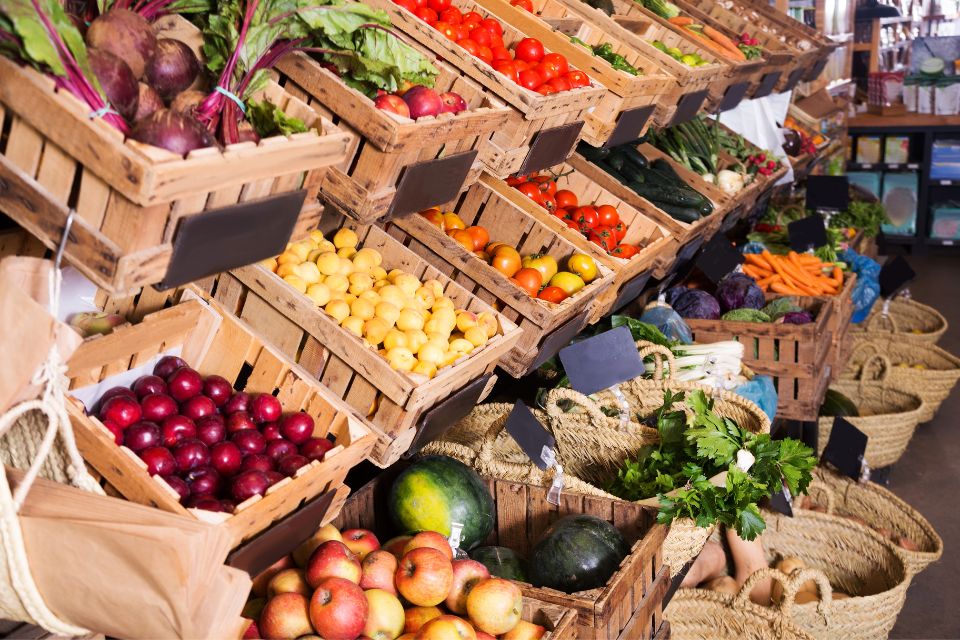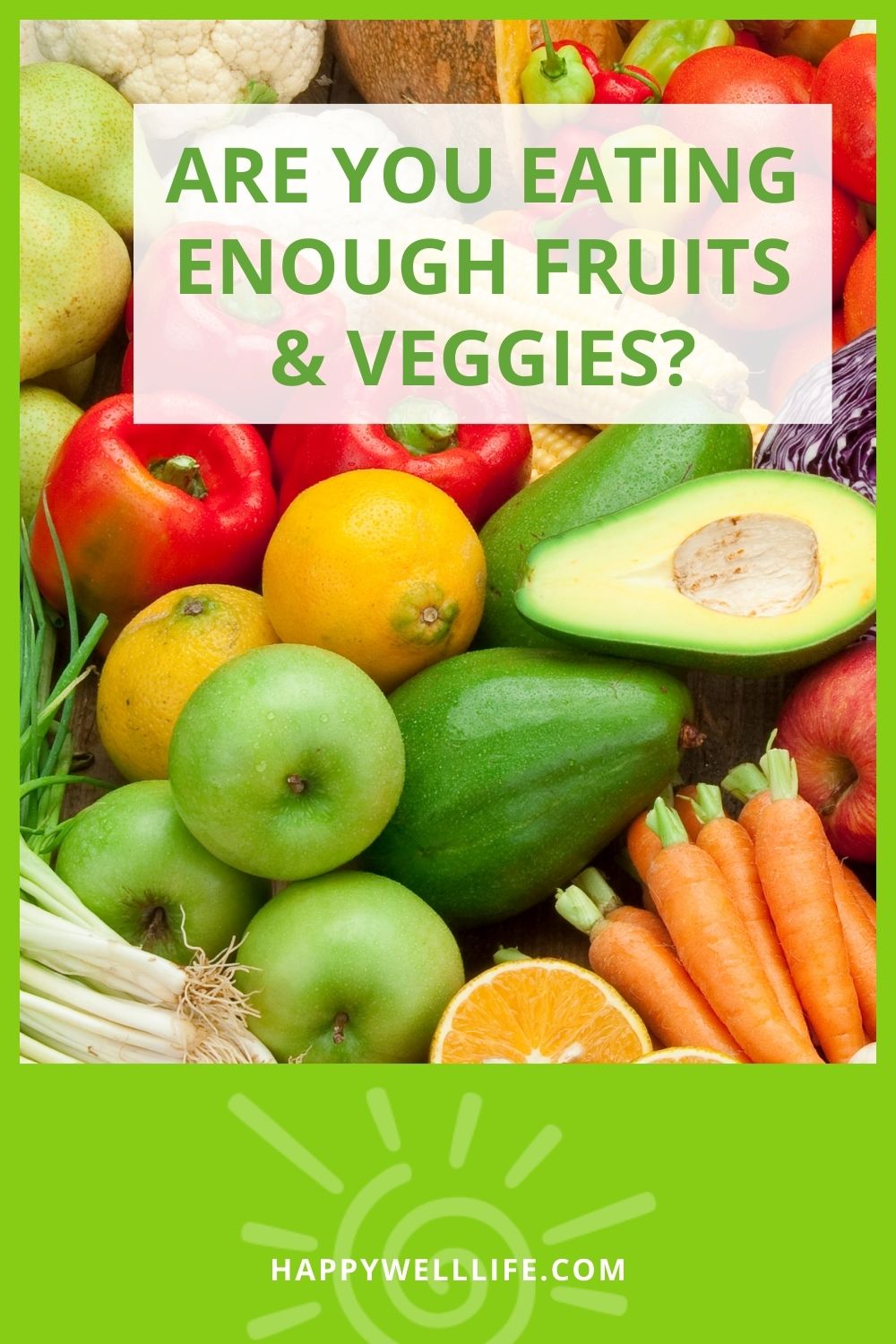Are You Eating Enough Fruits & Veggies?

Are you eating enough fruits and veggies? If you’re like most Americans the answer is likely “no”. Recent data from the Centers for Disease Control (CDC) indicates that just 1-in-10 American adults are eating enough fruits and veggies.(1) That means 90% of us are not getting enough fruits and veggies every day. Our children are equally deficient. And BIPOC communities are faring far worse.(2)
So what is the recommended amount of daily fruits and veggies anyway? The USDA’s “recommended amount” is 5 to 9 half-cup servings of fruits and veggies a day. But that is the bare minimum to survive, not to thrive.
If you’re going for optimal health instead of the bare minimum, according to research shared in Dr. Mark Hyman’s book Food Fix (which I highly recommend reading!), you’ll want to eat 13 to 15 half-cup servings of fruits and veggies every day—in a wide range of colors. And athletes need to eat even more. Wow! That’s a LOT. Especially when, ironically, only 2% of all agricultural land in the US is now used for growing fruits and vegetables.
Even as a functional medicine health coach, who eats pretty clean and healthy, I know I generally don’t eat 13 to 15 servings of fruits and veggies a day. How about you? It’s hard to wrap our heads around how much that really is. So let’s break it down a few different ways.
A visual guide for your fruits and veggies
You’ll want to eat about 1.5-2 cups of fruit a day, and the rest would be vegetables. So what do 13-15 half-cup servings of fruits and veggies look like? Here are three ways to visualize it.
- A minimum of 50% of your plate at every meal would optimally be veggies and fruits. Yep, you need veggies at breakfast too. (And some functional medicine experts are now saying 75% of your plate should be veggies at every meal.)
- A baseball is about the size of one cup. So if you’re measuring in baseball-sized portions, you’d need to eat 6-8 baseballs worth of fruits and veggies a day.
- Another way to look at it is a tennis ball is about the size of a half-cup serving. This means you’d need to eat 13-15 tennis balls worth of produce a day.

Why do we need so many fruits and veggies?
So why do we need SO many servings of fruits and veggies in a wide variety of colors anyway? There are a few different reasons. You might be thinking that your ancestors probably didn’t eat that many, and you’d be right. So what gives?
- Poor farming practices have led to nutrient-poor soils. So our produce today is lacking in many nutrients it used to contain. Today’s broccoli contains 50-80% fewer nutrients than it did in 1970.(3)(4) I’m gobsmacked! That’s in my lifetime. Gulp…
- Because Americans like to “Super-size” everything, the hybridization of produce in the past 50 years has also selected for larger size produce, over better nutrition.(5)
- Most conventionally raised produce is picked before fully ripe (when the nutrition fully develops). So you’re likely not getting all of the benefits you would from vine-ripened produce unless you’re growing it yourself.
- Conventionally raised produce is usually transported thousands of miles, and the produce starts to degrade from the time it’s picked to when it lands on your plate.
- 30% of Americans eat at least one fast-food meal a day, so processed food has crowded the fruits and veggies right off our plates.
- We’re exposed to more toxins today than ever before, so we need more phytonutrients to combat the effects of those toxins.

Importance of phytonutrients
What are phytonutrients? These are natural plant compounds that include antioxidants like polyphenols, carotenoids, and resveratrol to name a few. These phytonutrients are super-beneficial in keeping plants healthy. And when we eat enough of them they help keep us healthy too. They also provide us with beauty from the inside out, helping prevent or delay wrinkles by preventing our skin from aging prematurely, they can even protect our skin from sun damage. And we all want that, right?
You’ve likely heard of oxidation, a type of corrosion from exposure to oxygen. On cars or other metals, this becomes rust or oxidized paint (no shine). In our bodies, oxidative stress causes free radicals or a type of corrosion to our cells. Processed foods, rancid fats and oils, and physical/mental/emotional stress all lead to oxidation and free radicals in our cells. No bueno.
According to scientific research, “Free radical damage contributes to many chronic health problems including cardiovascular and inflammatory disease, cataracts, and cancer. Antioxidants prevent free-radical induced tissue damage by preventing the formation of radicals, scavenging them, or by promoting their decomposition.”(6)
However, most of us don’t eat enough variety of the vast rainbow of colors of produce available to us today. And so we don’t get enough phytonutrients either.(7) The color of the produce generally indicates the number of phytonutrients. The more deeply, richly colored the produce, the more phytonutrients it contains. And with the influx of toxins we’re being exposed to daily, (from the air we breathe, the water we drink, the toxins in household cleaners and health and beauty products, and from pesticides in our fruits and veggies, and processed foods full of synthetic ingredients), we need even more phytonutrients to keep us healthy.
Vitamins and minerals vs. phytonutrients
While vitamins and minerals are very important to healthy bodies, phytonutrients may be just as important or more so. There is new research being done all the time on the benefits of phytonutrients. (8) And it’s very possible that more vitamins will be discovered among the phytonutrients, one day soon.
- 70% of Americans are trying to fill gaps with a multivitamin
- A multivitamin contains a few isolated nutrients, whereas one apple has approximately 10,000 phytonutrients working synergistically. And a serving of broccoli has even more!
- According to research by the University of Allahabad in India, “Polyphenol-rich diets provide significant protection against the development and progression of many chronic conditions including cancer, diabetes, cardiovascular problems, and aging.”(9)
So how can you get more fruits and veggies into each day?
- Here are some ideas to help you get more veggies into your breakfast. You can also try adding veggies to your smoothies.
- For lunches try big salads with a wide variety of veggies, sprouts, and greens, plus some fish, chicken, or organic tofu for protein.
- For dinners, think of your protein as being the “side dish” (4-6 oz) with an array of vibrantly colored veggies like steamed broccoli, beets, sweet potatoes, and cauliflower for example.
- Check out my Recipes page for more ideas on eating more fruits and veggies each day.
Please share this article with your friends and family who are interested in living healthier lives too. And leave a comment to let us know your biggest takeaway.
——————————
References:
- https://www.cdc.gov/nccdphp/dnpao/division-information/media-tools/adults-fruits-vegetables.html
- https://www.cdc.gov/vitalsigns/fruit-vegetables/index.html
- https://www.scientificamerican.com/article/soil-depletion-and-nutrition-loss
- https://www.mindbodygreen.com/articles/broccoli-was-twice-as-nutritious-50-years-agoheres-why
- https://www.nytimes.com/2013/05/26/opinion/sunday/breeding-the-nutrition-out-of-our-food.html
- https://www.ncbi.nlm.nih.gov/pmc/articles/PMC3249911
- https://academic.oup.com/ajcn/article/81/1/215S/4607494
- https://pubmed.ncbi.nlm.nih.gov/25051278
